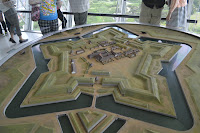Goryokaku Park is in the grounds of the star-shaped Goryokaku Fort and consists of approximately 251,000 square metres of moats, stone walls, lawns, pine and cherry trees, walkways, museums, and gardens.
 The European inspired fort was built between 1857 and 1864, during the final years of the Edo period to protect the Magistrate's Office and in response to the increasing presence of foreigners, later becoming site of the final battle of the Boshin Civil War between the remaining Edo shogunate supporters and the recently established Meiji Government.
The European inspired fort was built between 1857 and 1864, during the final years of the Edo period to protect the Magistrate's Office and in response to the increasing presence of foreigners, later becoming site of the final battle of the Boshin Civil War between the remaining Edo shogunate supporters and the recently established Meiji Government. The 1,600 odd cherry trees burst out in flower in early May, making for a spectacular scene and a popular site for hanami (cherry blosson viewing).
The fort can be viewed in its entirety 90 metres above from the Goryokaku Tower. The 107 metre high tower was opened in 2006, replacing an older one, and consists of two observation floors reached by a 30 second elevator ride. Here there are 360 degree views of Hakodate including the immediate site of the fort and the Yokotsu Mountain Range to the north, as well as Mount Hakodate and the Tsugaru Strait (between Hokkaido and Honshu) to the south.
 Plenty of information on the history is provided within the observatory through the models, tables, pictures, diagrams, and a computerised information terminal guide. Also look out for the statue of Toshizo Hijikata (a popular figure from the war) on the 2nd floor, and the windowed floor section on the 1st floor, where you can test your trust in the reinforced glass. There is also a small cafe, a souvenir shop, and an interesting photo display of star-shaped citadels of the world on the first floor of the observatory.
Plenty of information on the history is provided within the observatory through the models, tables, pictures, diagrams, and a computerised information terminal guide. Also look out for the statue of Toshizo Hijikata (a popular figure from the war) on the 2nd floor, and the windowed floor section on the 1st floor, where you can test your trust in the reinforced glass. There is also a small cafe, a souvenir shop, and an interesting photo display of star-shaped citadels of the world on the first floor of the observatory.
At the base of the tower, there's a large souvenir shop selling Goryokaku and Hakodate goods. Also at the base, on the second floor, is the Gotoken Hakodate Curry Express restaurant and the Milkissimo Gelato bar, which sells a variety of delicious flavours.

The original Hakodate Magistrate's Office operated as the area's administrative centre for just 7 years after its construction in 1864 until it was demolished following the Boshin War. A large section of it was faithfully reconstructed 140 years later in 2010 using original techniques and materials including Japanese earthen walls and plaster, and clay roof tiles and shingles. Half of the inside of the office has been accurately reproduced with traditional tatami rooms separated by large sliding doors opening to make a hall. The other half consists of interactive displays, a theatre room and exhibits on the construction and history of the office and region. Next to the building is an outline of part of the original building and its many rooms showing the tight spaces and corridors in which they worked in during its operation.
Map: https://maps.google.com/maps?hl=en&ll=41.796544,140.757608&spn=0.00955,0.01929&t=m&z=16
Goryokaku Fort (Park area)
Admission: Entry is free.
Open: 5am - 7pm (April to October), 5am - 6pm (November to March)
Goryokaku Tower
Admission: Adults 840 yen, junior and high school students 630 yen, primary school students 420 yen, children under 5 free (discount for groups of 30 or more).
Open: 8am - 7pm (April 21st to October 20th), 9am - 6pm (October 21st to April 20th)
Hakodate Magistrate's Office
Admission: Adults 500 yen, students and children 250 yen (discounts for groups of 20 or more, and certain Hakodate citizens).
Open: 9am - 6pm (April to October), 9am - 5pm (November to March). Closed December 31st to January 3rd.
Access: From Hakodate Station (函館駅)
Car/taxi: 15 minutes north-east from Hakodate Station.
Streetcar/tram: Get on the tram at the Hakodate Eki-mae (函館駅前) stop on the 'a' side (heading north). About 16 minutes later, get off at the Goryokaku Koen-mae (五稜郭公園前) stop and walk 15 minutes. Cost is 220 yen for adults, and 110 yen for children (All-day tram passes are 600 yen for adults and 300 yen for children). The tower is easy to see through the buildings and the direction (north) is well signed to help you find your way.
Bus: Go to bus stop number 5 in front of the station. Use buses 5-1, 6-2, 59, 105, 130, or 106ループ27. Get off after about 12 minutes at Goryokaku Koen Iriguchi Stop (五稜郭公園入口) and walk 5 minutes north-north-east. Cost is 200 yen for adults and 100 yen for children.
Parking: Nearby pay parking lots only:
Hakodate Performing Arts Centre Car Park (函館市芸術ホール駐車場) is on the south side of the park across the road from the tower and costs 200 yen for the first hour and 100 yen for each hour after that.
Hakodate Goryokaku Tourism Car Park (函館市五稜郭観光駐車場) is on the north-west side of the park across the road from the Hakodate City Central Library (函館市中央図書館) and costs 200 yen for the first hour and 100 yen for each hour after that.
Websites: Tower: http://www.goryokaku-tower.co.jp/
Magistrate's Office: http://www.hakodate-bugyosho.jp/index.html
(Japanese only)
Phone number: (0138) 51-4785 (Goryokaku Tower Corporation)
Address: 〒040-0001函館市五稜郭町43-9
 |
| Gotoken Hakodate Curry Express |
 |
| Milkissimo Gelato |





































